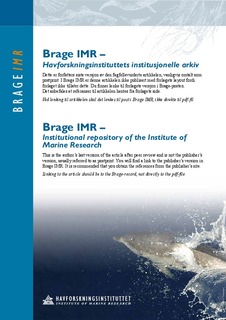| dc.contributor.author | Vølstad, Jon Helge | |
| dc.contributor.author | Dew, J.R. | |
| dc.contributor.author | Tarnowski, Mitchell | |
| dc.date.accessioned | 2010-10-20T07:37:26Z | |
| dc.date.available | 2010-10-20T07:37:26Z | |
| dc.date.issued | 2008-08 | |
| dc.identifier.issn | 0730-8000 | |
| dc.identifier.uri | http://hdl.handle.net/11250/109470 | |
| dc.description | 98 Annual Meeting National Shellfisheries Association, Monterey, CA (USA), 26-30 Mar 2006 | |
| dc.description.abstract | In an effort to restore the ecological role of oysters in Chesapeake Bay and the economic benefits of a commercial fishery, the states of Maryland and Virginia are considering introducing the nonnative Asian oyster (Crassostrea ariakensis) into the Bay. As part of an ecological risk assessment (ERA) to evaluate the proposed action and alternatives, demographic modeling is being used to project the change in populations of both the Asian and the native eastern oyster (C. virginica) in the Bay across space and time. Annual mortality rates are vital input to the demographic model. We present two approaches for parameterizing mortality rates for C. virginica by salinity ranges and disease-intensity categories and discuss how these rates could be applied to project population growth for the Asian oyster. We estimated mortality rates from empirical data collected during annual dredge surveys of oyster beds in Maryland. We compared counts of recent boxes (dead oysters without fouling or sedimentation on the inner valve surfaces, including “gapers” of one or two weeks old with tissue remaining in the shell), old boxes (dead oysters without tissue remnants but with fouling, sedimentation or both on the inner valve surfaces), and live oysters in market-size and small classes. Our mortality estimates based on counts of recent boxes consistently differentiated between years with high disease intensity and those with low disease intensity, between wet and dry years, and between salinity zones. In contrast, traditional estimates of yearly mortality based on total box counts often were out of phase with measured levels of disease intensity and weather (dry or wet). To model populations of C. ariakensis, we propose to adjust the mortality rates for C. virginica based on research results that provide estimates of differences between the two species' resistance to MSX and dermo and to other mortality factors, such as predation. | |
| dc.language.iso | eng | en_US |
| dc.publisher | National Shellfisheries Association | |
| dc.title | Estimation of annual mortality rates for eastern oysters (Crassostrea virginica) in Chesapeake Bay based on box counts and application of those rates for projection of population growth of both C. virginica and the Asian oyster (C. ariakensis) | en_US |
| dc.type | Journal article | en_US |
| dc.type | Peer reviewed | |
| dc.source.pagenumber | 525-533 | |
| dc.source.volume | 27 | |
| dc.source.journal | Journal of Shellfish Research | |
| dc.source.issue | 3 | |
| dc.identifier.doi | 10.2983/0730-8000(2008)27[525:EOAMRF]2.0.CO;2 | |
